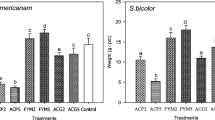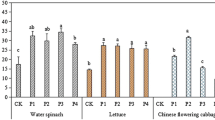Abstract
Purpose
The contamination of agricultural soils by heavy metals is a worldwide problem. Organic amendments can be used for the immobilization and binding of heavy metal ions in soils by complexation, adsorption, and precipitation. A field trial was carried out to evaluate the influence of some low-cost organic materials such as rice straw (RS), green manure (GM), and pig manure (PM) on the distribution of Cu and Cd and the retention of these metals by organic matter fractions in heavy metal-polluted soils.
Materials and methods
The experiment was conducted in Miaoyunao Village, Daye County, Hubei province, China. PM, GM (peanut plants), and RS were obtained from a farm close to the village. Sixteen treatments with three replicates were designed. Soil chemical properties such as soil pH, electrical conductivity (EC), organic matter (OM), and available P were measured by standard methods. Soluble/exchangeable, organic-bound, inorganic precipitates and residual Cu and Cd in the soil were sequentially extracted and analyzed. The amounts of Cu and Cd bound with soil particulate organic matter (POM) fractions and humic substances were also determined.
Results and discussion
The addition of organic amendments declined significantly the concentrations of soluble/exchangeable Cu and Cd, but increased the amounts of these metals in organic-bound and inorganic precipitate forms in the soil. RS was more effective than GM and PM in diminishing the solubility of Cu and Cd. The largest retention for Cu and Cd by humic substances and POM was noticed in RS treatments, whereas the lowest was found in PM treatments. Humic substances showed higher potential in the fixation of Cu and Cd than POM fractions. The conversion of soluble/exchangeable Cu and Cd to other insoluble forms after the application of organic amendments may be ascribed to the increases of soil OM, pH, EC, and available P contents. The highest binding of Cu and Cd with POM fractions and humic substances after the incorporation of RS mainly resulted from the greatest increase of soil OM contents.
Conclusions
RS, GM, and PM can be employed as good and cheap substances for the immobilization of Cu and Cd in heavy metal-polluted soils. RS was the best amendment in decreasing the solubility of Cu and Cd, and also in enhancing the retention of these metals by humic substances and POM fractions in the soil. Futures studies should focus on the influence of these organic amendments or their mixtures on the phytotoxicity of Cu and Cd for different plants in heavy metal-contaminated soils.





Similar content being viewed by others
References
Abbas ST, Sarfras M, Mehdi SM, Hassan G, Rehman OU (2007) Trace element accumulation in soil and rice plants irrigated with the contaminated water. Soil Tillage Res 94:503–509
Balabane M, Faivre D, van Oort F, Dahmani-Muller H (1999) Mutual effects of soil organic matter dynamics and heavy metals fate in a metallophyte grassland. Environ Pollut 105:45–54
Balescient J (1996) The significance of organic separates to carbon dynamics and its modeling in some cultivated soils. Euro J Soil Sci 4(7):485–493
Bernal MP, Clemente R, Walker DJ (2007) The role of organic amendments in the bioremediation of heavy metal-polluted soils. In: Gore RW (ed) Environmental research at the leading edge. Nova Science Publishers Inc., New York, pp 1–57
Cang L, Wang YJ, Zhou DM, Dong YH (2004) Study of heavy metals pollution in poultry and livestock feeds and manures under intensive farming in Jiangsu province. J Environ Sci 16:371–374
Chen ZS, Lee GJ, Liu JC (2000) The effects of chemical remediation treatments on the extractability and speciation of cadmium and lead in contaminated soils. Chemosphere 41:235–242
Donisa C, Mocanu R, Steinnes E (2003) Distribution of some major and minor elements between fulvic and humic acid fractions in natural soils. Geoderma 111:75–84
Goering HK, van Soest PJ (1970) Forage fiber analyses (apparatus, reagents, procedures and some applications). In: Agricultural handbook. USDA-ARS, Washington, p 379
Gondar D, López R, Fiol S, Antelo JM, Arce F (2006a) Cadmium, lead, and copper binding to humic acid and fulvic acid extracted from an ombrotrophic peat bog. Geoderma 135:196–203
Gondar D, López R, Fiol S, Antelo JM, Arce F (2006b) Copper binding by peat fulvic and humic acids extracted from two horizons of an ombrotrophic peat bog. Chemosphere 63:82–88
Gregorich EG, Beare MH, McKim UF, Skjemstad JO (2006) Chemical and biological characteristics of physically uncomplexed organic matter. Soil Sci Soc Am J 70:975–985
Hess PR (1972) A textbook of soil chemical analysis. Chemical Publishing Co. Inc., New York, pp 197–299
Karaca A (2004) Effect of organic wastes on the extractability of cadmium, copper, nickel, and zinc in soil. Geoderma 122:297–303
Klute A (1986) Methods of soil analysis. Part I. Physical and mineralogical methods. Am Soc Agron (ASA) Monograph 9:635–662
Labanowski J, Sebastia J, Foy E, Jongmans T, Lamy I, Van Oort F (2007) Fate of metal-associated POM in a soil under arable land use contaminated by metallurgical fallout in northern France. Environ Pollut 149:59–69
Li P, Wang X, Zhang T, Zhou D, HE Y (2008) Effects of several amendments on rice growth and uptake of copper and cadmium from a contaminated soil. J Environ Sci 20:449–455
Liu L, Chen HC, Cai P, Liang W, Huang Q (2009) Immobilization and phytotoxicity of Cd in contaminated soil amended with chicken manure compost. J Hazard Mat 163:563–567
Mench MJ, Didier VL, Loffler M, Gomez A, Masson P (1994) A mimicked in-situ remediation study of metal-contaminated soils with emphasis on cadmium and lead. J Environ Qual 23:58–63
Nelson SD, Sommers LE (1982) Total carbon, organic carbon, and organic matter. In: Page AL et al. (eds) Methods of soil analysis, part 2, 2nd ed. Agronomy Monograph 9. ASA-SSSA, Madison, WI, pp 539–579
Quartacci MF, Argilla A, Baker AJM, Navari-Izzo F (2006) Phytoextraction of metals from amultiply contaminated soil by Indian mustard. Chemosphere 63:918–925
Rattan RK, Datt AS, Chhonkar PK, Suribabu K, Singh AK (2005) Long-term impact of irrigation with sewage effluents on heavy metal content in soils, crops and groundwater—a case study. Agric Ecosyst Environ 67:824–837
Reyes-Solís IE, Solís C, Isaac-Olive K, García NE, Andrade E (2009) Fractionation analysis of trace metals in humic substances of soils irrigated with wastewater in Central Mexico by particle induced X-ray emission. Microchemical J 91:129–132
Rocha CG, Zaia DAM, Alfaya RVD, Alfaya AAD (2009) Use of rice straw as biosorbent for removal of Cu(II), Zn(II), Cd(II) and Hg(II) ions in industrial effluents. J Hazard Mat 166:383–388
Rulkens WH, Tichy R, Grotenhuis JTC (1998) Remediation of polluted soil and sediment: perspectives and failures. Water Sci Technol 37:27–35
Schnitzer M (1982) Organic matter characterization. In: Page AL, Miller RH, Keeney DR (eds) Methods of soil analysis, part 2. Chemical and microbiological properties (2nd ed.), Chapter 30. American Society of Agronomy and Soil Science Society of America, Madison, WI, pp 581–594
Sebastia J, van Oort F, Lamy I (2008) Buffer capacity and Cu affinity of soil particulate organic matter (POM) size fractions. Euro J Soil Sci 59:304–314
Shuman LM (1999) Organic waste amendments effect on zinc fractions of two soils. J Environ Qual 28:1442–1447
Sposito G, Lund LJ, Chang AC (1982) Trace metal chemistry in arid zone field soils amended with sewage sludge. I. Fractionation of Ni, Cu, Zn, Cd and Pb in solid phases. Soil Sci Soc Am J 46:260–264
Stevenson FJ (1994) Humus chemistry: genesis, composition, reactions, 2nd edn. Wiley, New York, pp 24–34
Thomas GW (1996) Soil pH and soil acidity. In: Bigham JM, Bartels JM (eds) Methods of soil analysis, part 3. Chemical methods. ASA–SSSA, Madison, pp 475–490
Udom BE, Mbagwu JSC, Adesodun JK, Agbim NN (2004) Distributions of zinc, copper, cadmium and lead in tropical Ultisol after long-term disposal of sewage sludge. Environ Int 30:467–470
Walker DJ, Clemente R, Roig A, Bernal MP (2003) The effects of soil amendments on heavy metal bioavailability in two contaminated Mediterranean soils. Environ Pollut 122:303–312
Walker DJ, Clemente R, Bernal P (2004) Contrasting effects of manure and compost on soil pH, heavy metals availability and growth of chemopodium album in a soil contaminated by pyritic mine waste. Chemosphere 57:215–224
Wang J, Zhang CB, Jin ZX (2009) The distribution and phytoavailability of heavy metal fractions in rhizosphere soils of Paulowniu fortunei (seem) Hems near a Pb/Zn smelter in Guangdong, PR China. Geoderma 148:299–306
Zhang J, Daia J, Wang R, Li F, Wang W (2009) Adsorption and desorption of divalent mercury (Hg) on humic acids and fulvic acids extracted from typical soils in China. Colloids Surf, A Physicochem Eng Asp 335:194–201
Acknowledgments
The authors would like to thank the National High Technology Research and Development Program of China (‘863’ Program) for the financial support of this work (2006AA06Z350).
Author information
Authors and Affiliations
Corresponding author
Additional information
Responsible editor: Nicole J. Mathers
Rights and permissions
About this article
Cite this article
Mohamed, I., Ahamadou, B., Li, M. et al. Fractionation of copper and cadmium and their binding with soil organic matter in a contaminated soil amended with organic materials. J Soils Sediments 10, 973–982 (2010). https://doi.org/10.1007/s11368-010-0199-1
Received:
Accepted:
Published:
Issue Date:
DOI: https://doi.org/10.1007/s11368-010-0199-1




